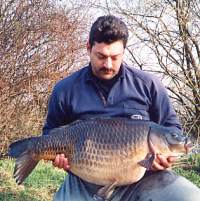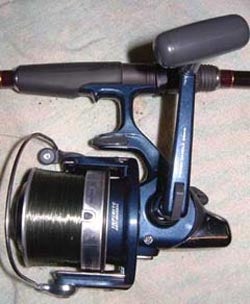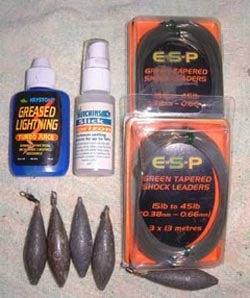Rik started fishing at the age of four on his local tiny tidal river, catching eels and small wild trout on worm. Not having had any angling family members, all his early fishing was solitary and this seems to have carried through to the present. Like most anglers nowadays, he has a full time job and a family, so his fishing time is limited, although he does, he tells us, have a very understanding wife.He currently lives in the depths of Hampshire, and so is within easy reach of some excellent venues. He has in the past, and still does, fish for most species, although his greatest love is for carp fishing, which is how the majority of his time is spent. He now finds himself more thrilled with overcoming the intricacies and problems associated with catching carp, rather than the actual weight of the fish he catches and the so-called glory that goes with it.
| ||||
| FISHING AT LONG RANGE In carp fishing it is not always necessary to cast to the horizon as fish can be caught much more easily under the rod tips, but long range fishing is an essential part of the armoury of the adaptable carp angler to allow him to maximise any given opportunities. If carp are showing at a distant feature then you need to be able to put a bait to them. In this article I will detail the tackle and techniques required to fish at long range, but I will not attempt to quantify what long range is, for people have different needs and so this can be anything between 80 and 160 yards. I will not dictate to you what is or isn’t long range, I will just offer you the advice. The rod The most common size of rod sold nowadays is 12′ in length and between 2 1/2 and 3lb TC, so the chances are that you already own the ideal tool. For gaining maximum distance the ideal rod has a mainly tip action with a very fast tip recovery speed. If your rod has a more through-action, then good distances can still be achieved, it just means that the power transfer on the casting action will need to be applied more slowly. (more of that later).
Too many rings and there is a build up of friction that will cut the casting distance. Too few rings and slack line is created in the spacing between the rings, causing the line to slap the blank and, again, increase friction. Another problem associated with this slack line is that it can wrap around the legs of the ring and cause either a tangle, or, if you are casting quite hard, then a crack-off can occur. Ring sizes are also important and their size should be determined, in conjunction with their position on the rod, by the size of the coils coming off the reel to produce a smooth tapering cone to the rod tip. This is very complicated to ascertain, so try to ensure that your rod has a butt ring of at least 40mm in diameter. Also ensure that it is far enough away from the reel, so that line leaving the spool has had time to straighten and is not entering the butt ring while it is still coiled.Tip rings should ideally be between 12 and 16mm, to allow the unhindered passage of shockleader knots. The reel Most carp reels, because of their size, will enable you to cast a long way. But to maximise the chances of gaining the most distance then you really need to use a ‘big pit’ type reel.
The advantages offered by these reels has nothing to do with the capacity of line they can hold, but has more to do with the diameter and height of the spool.Because the spool diameter is so large, when line leaves the reel on the cast the depth between the lip of the spool and the line left on the spool is not as great as that on a spool of smaller proportions, and thus less friction is created and a longer cast is made. People in the past have advocated that ‘big pit’ type reels are not necessary when using lines below 12lb. My own findings, and those of my friends, show this to be complete and utter rubbish. I can give many instances where I have changed from an 8010 Baitrunner to a big pit reel, with the same rod, set-up and reel line (10lb) and the larger reel has increased my distance by 10 or 15 yards. That is not classroom theory, that is fact. The Line The mainline should be substantial enough to land the size of fish you are seeking, taking into account the condition of the lake and the proximity of weed, pads, snags etc. It is foolish to fish with 10lb mainline to maximise the distance, if you are going to lose every fish you hook in a marginal snag because your line is too light. Except in extreme circumstances, I always fish with 12 or 15lb line.The extremes are two lakes that I fish where the fish congregate around a large distant island because, other than the margins, it is the only feature in the lake.There are absolutely no snags, not even a scrap of weed, so on this lake I am happy to use 10lb line to attempt to gain a few extra yards. Certain brands of line have less memory than other brands and these are certainly better for casting. The brands that I have faith in and use are Suffix Synergy and Shimano Technium. Some people advocate the use of braid for distance fishing because of its high strength and low diameter and having used it quite extensively, I have not found that it makes that much of a dramatic difference to the distance achieved. Line Lubrication I sometimes apply a lubricant to my line to improve distance. Line lubricants reduce friction and thus longer casts are made. They also need to be re-applied after several hours in the water, as they tend to ‘wash off’. I use either Kryston’s Greased Lightning (drop applicator), or Rod Hutchinson’s Slick Horizon (spray applicator). The shockleader. Shockleaders are very important when trying to maximise distance. If you are putting a lot of power into a cast then a safety aspect needs to be built in, otherwise your mainline will not stand the abuse and you could suffer a ‘crack-off’.
I use tapered shockleaders made by ESP and I have total faith in these. They are available in several breaking strains. An example is that the leader is tapered from 12 to 35lb. The 12lb end is attached to your mainline which means that because the lines are of a similar diameter the joining knot can be kept smaller, causing less problems and friction when going through the rings. The knot I use to join the lines is a simple double grinner and this is glued for extra security. The lead – size, style and arrangement. Size Lead size is a very important factor. Too small and you will not be able to generate enough compression in the rod to enable a good cast. Too large a lead and you will either compress the rod too early and lose all the power, or you may well, in extreme circumstances, snap the rod. Here is a very rough guide to enable you to gauge what size of lead your rod can handle. It converts the TC to ounces, and then you need to add half an ounce. A 2 1/2 lb TC rod converts to 2 1/2 oz + 1/2 oz = 3oz. This is a very rough guide and does not take into account the action of the rod, the quality of the rod, or the casting action, all of which will effect the maximum usable lead size. StyleThe style of the lead is very important. A short, dumpy lead, although a great aid to resistance and self hooking, has very poor aerodynamics and will not cast as far as a more elongated weight-forward design. Some purpose made distance leads are available, the originals being the Zipp lead, but all current lead manufacturers produce a distance inline and pendant style lead. The way that the lead is attached to the line is one of the most important factors.Because of the way that inline leads have the rig swivel pushed into their nose, when the cast is made the rig will trail behind the lead and cause the nose to veer off course, decreasing the accuracy and the distance of the cast, rendering them virtually useless. To a lesser extent, this is also true of a pendant arrangement.
The biggest problem when using a helicopter set-up with a shockleader is ensuring that the rig is anti-tether, ie, that it can be ejected safely and pass over the shockleader knot reasonably unhindered. The importance of this cannot be stressed enough, as the safety of the carp is paramount in any fishing situation.Test the rig several times to ensure that it can clear the shockleader knot and then test it again. Safety, safety, safety. Probably the best rig to use with this is the CV safety rig, as it has a large bore on the top of the D that will allow it to pass over even the largest of knots. (see photo). Casting technique This is without doubt the most important aspect that will determine how far you will cast. Give a good caster average gear and he will still cast a long way. | ||||
A re-cap on the safety points. Please remember and adhere to all the safety points. As I said at the start, distance fishing is not the only method available to catch carp, but it is a skill that should be learnt and practised so it is available if required. A video of me making a long distance cast can be downloaded here. |
Welcome!Log into your account
















